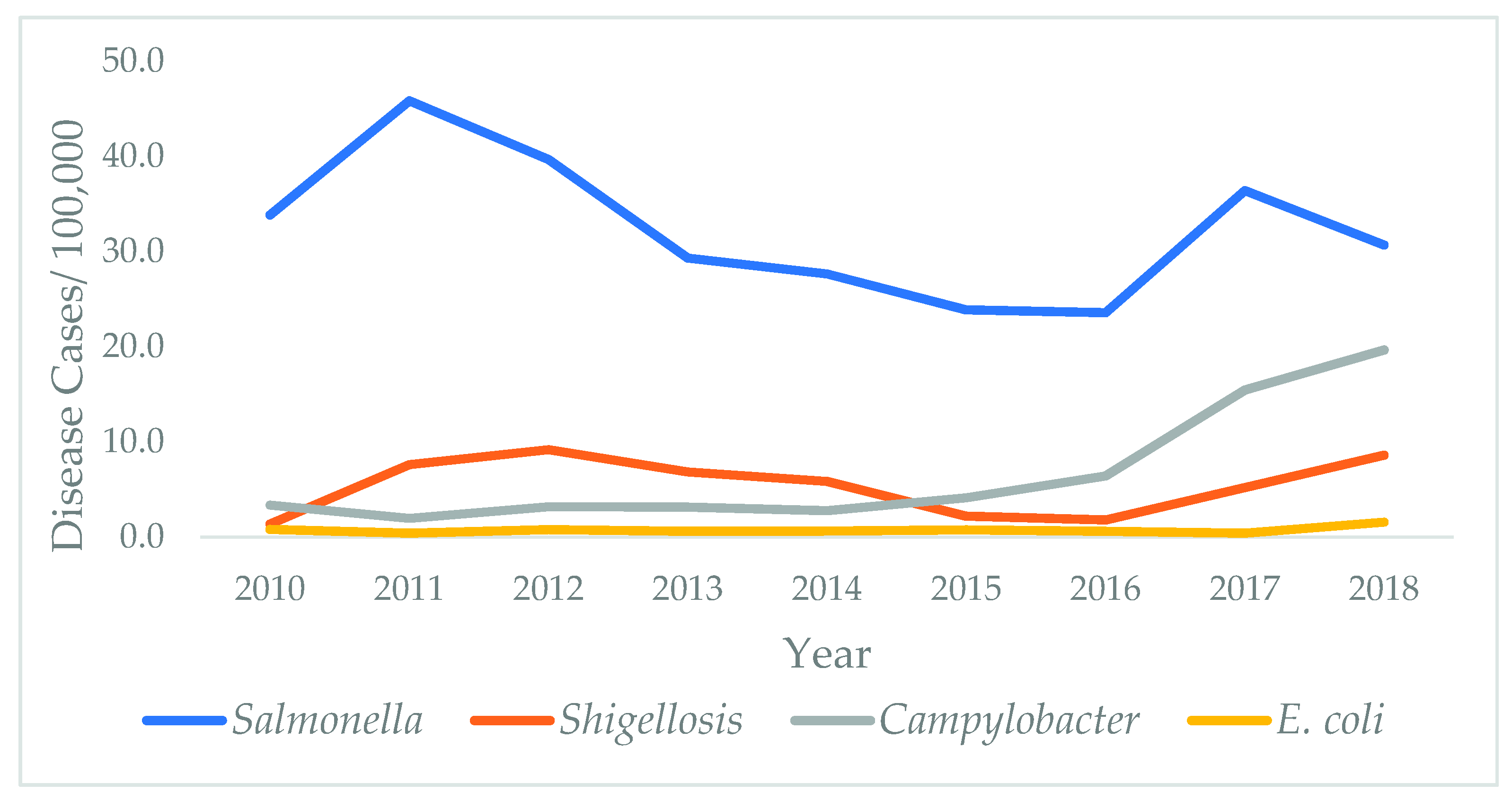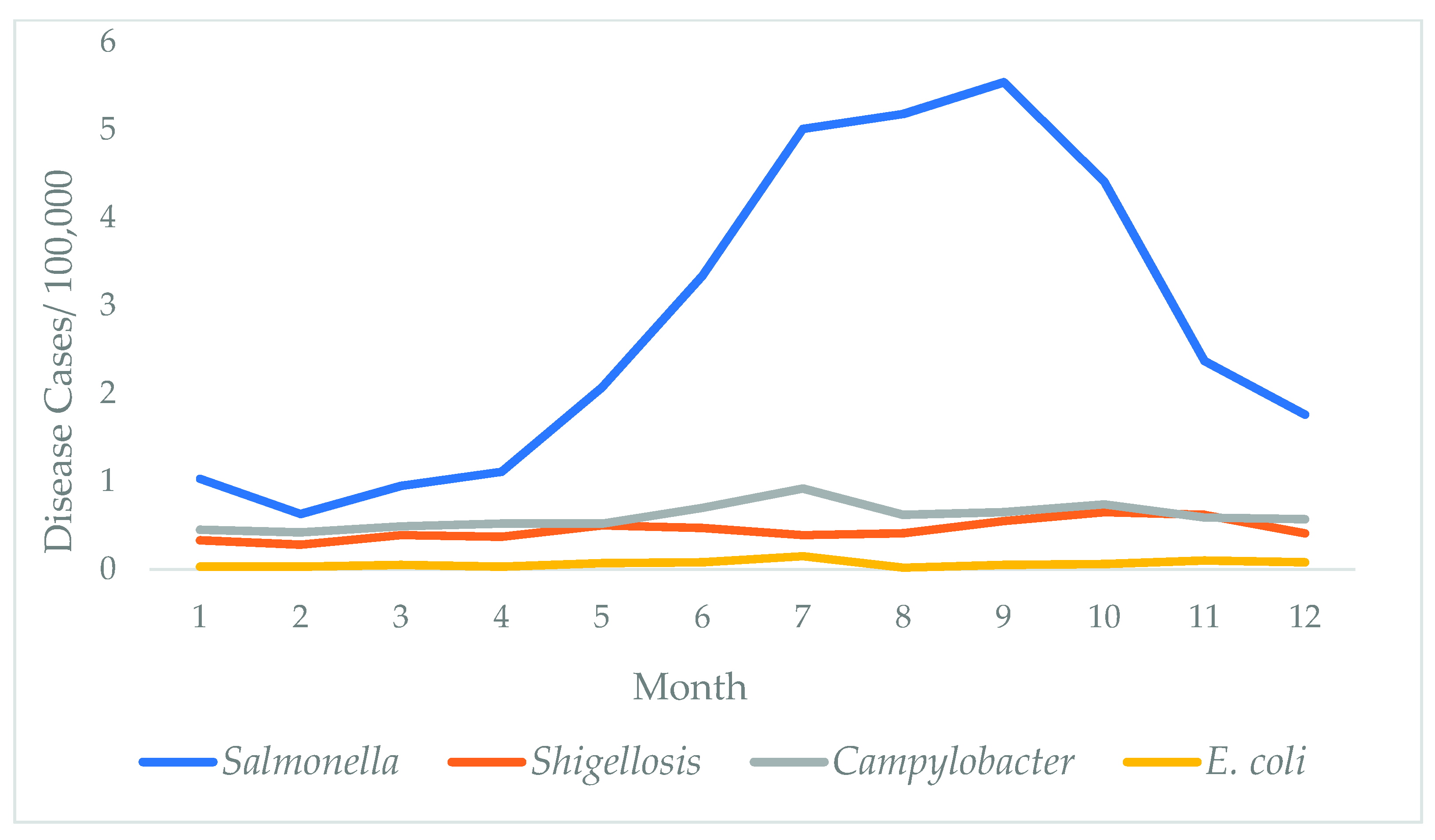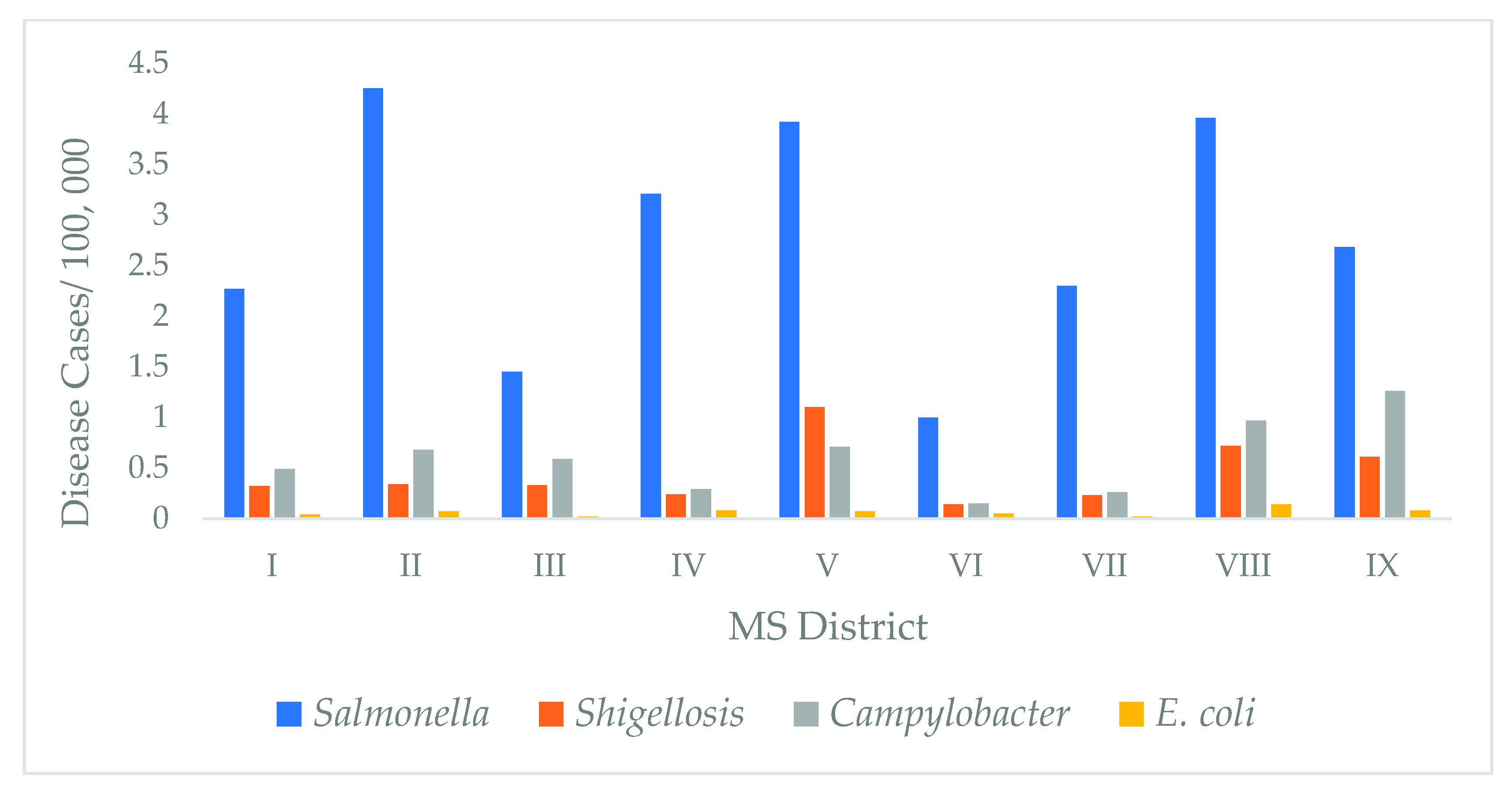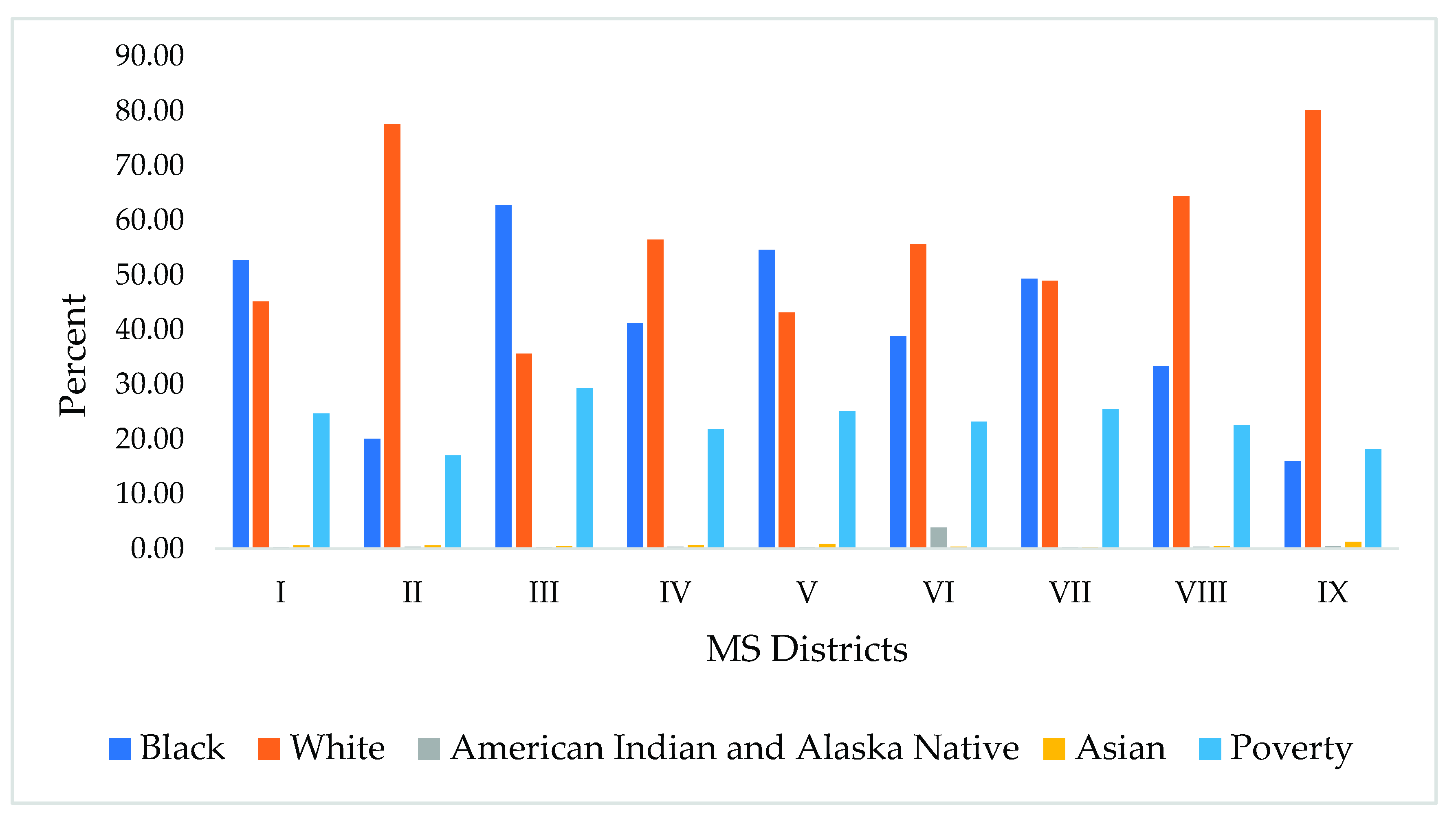Trends of Foodborne Diseases in Mississippi: Association with Racial and Economic Disparities
Abstract
:1. Introduction
2. Materials and Methods
2.1. Data Collection
2.2. Statistical Analysis
3. Results
4. Discussion
5. Conclusions
6. Limitations
Funding
Institutional Review Board Statement
Informed Consent Statement
Data Availability Statement
Conflicts of Interest
References
- Scallan, E.; Hoekstra, R.M.; Angulo, F.J.; Tauxe, R.V.; Widdowson, M.A.; Roy, S.L.; Jones, J.L.; Griffin, P.M. Foodborne illness acquired in the United States—Major pathogens. Emerg. Infect. Dis. 2011, 17, 7–15. [Google Scholar] [CrossRef] [PubMed]
- Centers for Disease Control and Prevention (CDC). Foodborne Illnesses and Germs. Available online: https://www.cdc.gov/foodsafety/foodborne-germs.html (accessed on 30 January 2020).
- Dewey-Mattia, D.; Kisselburgh, H.; Manikonda, K.; Silver, R.; Subramhanya, S.; Sundararaman, P.; Whitham, H.; Crowe, S. Surveillance for Foodborne Disease Outbreaks–United States, 2016: Annual Report; U.S. Department of Health and Human Services, CDC: Atlanta, GA, USA, 2018.
- United States Department of Agriculture Economic Research Service: Cost Estimates of Foodborne Illnesses. Available online: https://www.ers.usda.gov/data-products/cost-estimates-of-foodborne-illnesses/ (accessed on 15 July 2021).
- Akil, L.; Ahmad, H.A.; Reddy, R.S. Effects of climate change on Salmonella infections. Foodborne Pathog. Dis. 2014, 11, 974–980. [Google Scholar] [CrossRef] [PubMed] [Green Version]
- Akil, L.; Ahmad, H.A. Salmonella infections modelling in Mississippi using neural network and geographical information system (GIS). BMJ Open 2016, 6, e009255. [Google Scholar] [CrossRef] [PubMed] [Green Version]
- Akil, L.; Ahmad, H.A. Quantitative Risk Assessment Model of Human Salmonellosis Resulting from Consumption of Broiler Chicken. Diseases 2019, 7, 19. [Google Scholar] [CrossRef] [PubMed] [Green Version]
- Quinlan, J.J. Foodborne illness incidence rates and food safety risks for populations of low socioeconomic status and minority race/ethnicity: A review of the literature. Int. J. Environ. Res. Public Health 2013, 10, 3634–3652. [Google Scholar] [CrossRef] [PubMed]
- Centers for Disease Control and Prevention (CDC); Surveillance Resource Center. Estimates of Foodborne Illness in the United States. 2018. Available online: https://www.cdc.gov/foodborneburden/2011-foodborneestimates.html (accessed on 15 July 2021).
- Centers for Disease Control and Prevention (CDC): Salmonella. Available online: https://www.cdc.gov/salmonella/index.html (accessed on 15 July 2021).
- Centers for Disease Control and Prevention (CDC). Campylobacter (Campylobacteriosis) Outbreaks. Available online: https://www.cdc.gov/campylobacter/outbreaks/outbreaks.html (accessed on 15 July 2021).
- Centers for Disease Control and Prevention (CDC), Shigella Sources of Infections and Risk Factors. Available online: https://www.cdc.gov/shigella/infection-sources.html (accessed on 15 July 2021).
- Kendrovski, V.; Gjorgjev, D. Climate change: Implication for food-borne diseases (Salmonella and food poisoning among humans in R. Macedonia). In Structure and Function of Food Engineering; INTECH: Rijeka, Croatia, 2012; pp. 151–170. [Google Scholar]
- Cissé, G. Food-borne and water-borne diseases under climate change in low-and middle-income countries: Further efforts needed for reducing environmental health exposure risks. Acta Trop. 2019, 194, 181–188. [Google Scholar] [CrossRef] [PubMed]
- Crim, S.M.; Chai, S.J.; Karp, B.E.; Judd, M.C.; Reynolds, J.; Swanson, K.C.; Nisler, A.; McCullough, A.; Gould, L.H. Salmonella enterica Serotype Newport Infections in the United States, 2004–2013: Increased Incidence Investigated Through Four Surveillance Systems. Foodborne Pathog. Dis. 2018, 15, 612–620. [Google Scholar] [CrossRef] [PubMed]
- Sarki, M.; Robertson, A.; Parlesak, A. Association between socioeconomic status of mothers, food security, food safety practices and the double burden of malnutrition in the Lalitpur district, Nepal. Arch Public Health 2016, 74, 35. [Google Scholar] [CrossRef] [PubMed] [Green Version]
- Strassle, P.D.; Gu, W.; Bruce, B.B.; Gould, L.H. Sex and age distributions of persons in foodborne disease outbreaks and associations with food categories. Epidemiol. Infect. 2019, 147, e200. [Google Scholar] [CrossRef] [PubMed] [Green Version]
- McCrickard, L.S.; Crim, S.M.; Kim, S.; Bowen, A. Disparities in severe shigellosis among adults—Foodborne diseases active surveillance network, 2002–2014. BMC Public Health 2018, 18, 720. [Google Scholar] [CrossRef] [PubMed] [Green Version]
- The United States Census Bauru, Mississippi Quick Facts. Available online: https://www.census.gov/quickfacts/MS (accessed on 12 September 2021).
- Whitney, B.M.; Mainero, C.; Humes, E.; Hurd, S.; Niccolai, L.; Hadler, J.L. Socioeconomic Status and Foodborne Pathogens in Connecticut, USA, 2000–2011(1). Emerg. Infect. Dis. 2015, 21, 1617–1624. [Google Scholar] [CrossRef] [PubMed] [Green Version]
- Angelo, K.; Nisler, A.; Hall, A.; Brown, L.; Gould, L. Epidemiology of restaurant-associated foodborne disease outbreaks, United States, 1998–2013. Epidemiol. Infect. 2017, 145, 523–534. [Google Scholar] [CrossRef] [PubMed] [Green Version]
- Chang, M.; Groseclose, S.; Zaidi, A.; Braden, C. An ecological analysis of sociodemographic factors associated with the incidence of Salmonellosis, Shigellosis, and E. coli o157:H7 infections in US counties. Epidemiol. Infect. 2009, 137, 810–820. [Google Scholar] [CrossRef] [PubMed] [Green Version]
- Younus, M.; Hartwick, E.; Siddiqi, A.A.; Wilkins, M.; Davies, H.D.; Rahbar, M.; Funk, J.; Saeed, M. The role of neighborhood level socioeconomic characteristics in Salmonella infections in Michigan (1997–2007): Assessment using geographic information system. Int. J. Health Geogr. 2007, 6, 56. [Google Scholar] [CrossRef] [PubMed] [Green Version]





| Pathogen | Percent |
|---|---|
| Campylobacter | 15.5 |
| Escherichia coli O157:H7 | 0.9 |
| Hepatitis A | 0.4 |
| Listeriosis | 0.4 |
| Non-O1 And Other Vibrio spp. | 0.4 |
| Salmonellosis | 80.1 |
| Shiga Toxin-Producing E. coli (Stec) | 1.6 |
| Shigellosis | 9.35 |
| Vibrio parahaemolyticus | 0.2 |
| Vibrio vulnificus | 0.4 |
| Race | Percent |
|---|---|
| American Indian or Alaska Native | 0.3 |
| Asian | 0.3 |
| Black or African American | 14.1 |
| Black or African American; Other Race | 0 |
| Black or African American; White | 0 |
| Native Hawaiian or Other Pacific Islander | 0 |
| Native Hawaiian or Other Pacific Islander; Asian | 0 |
| Other Race | 4.1 |
| Other Race; Black or African American | 0 |
| Other Race; White | 0 |
| Unknown | 36 |
| White | 45.1 |
| White; Asian | 0 |
| White; Black or African American | 0 |
| White; Other Race | 0 |
| Total | 100 |
| District | Black | White | American Indian And Alaskan Native | Asian | Poverty | Salmonella | Shigella | Campylobacter | E. coli |
|---|---|---|---|---|---|---|---|---|---|
| I | 52.70 | 45.20 | 0.31 | 0.60 | 24.69 | 2.27 | 0.32 | 0.49 | 0.04 |
| II | 20.07 | 77.62 | 0.37 | 0.60 | 17.07 | 4.25 | 0.34 | 0.68 | 0.07 |
| III | 62.73 | 35.63 | 0.29 | 0.50 | 29.38 | 1.45 | 0.33 | 0.59 | 0.02 |
| IV | 41.28 | 56.52 | 0.40 | 0.65 | 21.88 | 3.21 | 0.24 | 0.29 | 0.08 |
| V | 54.61 | 43.20 | 0.29 | 0.93 | 25.14 | 3.92 | 1.10 | 0.71 | 0.07 |
| VI | 38.89 | 55.67 | 3.88 | 0.39 | 23.27 | 1.00 | 0.14 | 0.15 | 0.05 |
| VII | 49.32 | 49.01 | 0.33 | 0.32 | 25.48 | 2.30 | 0.23 | 0.26 | 0.02 |
| VIII | 33.41 | 64.50 | 0.38 | 0.53 | 22.62 | 3.96 | 0.72 | 0.97 | 0.14 |
| IX | 16.00 | 80.20 | 0.57 | 1.28 | 18.28 | 2.68 | 0.61 | 1.26 | 0.08 |
Publisher’s Note: MDPI stays neutral with regard to jurisdictional claims in published maps and institutional affiliations. |
© 2021 by the author. Licensee MDPI, Basel, Switzerland. This article is an open access article distributed under the terms and conditions of the Creative Commons Attribution (CC BY) license (https://creativecommons.org/licenses/by/4.0/).
Share and Cite
Akil, L. Trends of Foodborne Diseases in Mississippi: Association with Racial and Economic Disparities. Diseases 2021, 9, 83. https://doi.org/10.3390/diseases9040083
Akil L. Trends of Foodborne Diseases in Mississippi: Association with Racial and Economic Disparities. Diseases. 2021; 9(4):83. https://doi.org/10.3390/diseases9040083
Chicago/Turabian StyleAkil, Luma. 2021. "Trends of Foodborne Diseases in Mississippi: Association with Racial and Economic Disparities" Diseases 9, no. 4: 83. https://doi.org/10.3390/diseases9040083
APA StyleAkil, L. (2021). Trends of Foodborne Diseases in Mississippi: Association with Racial and Economic Disparities. Diseases, 9(4), 83. https://doi.org/10.3390/diseases9040083





